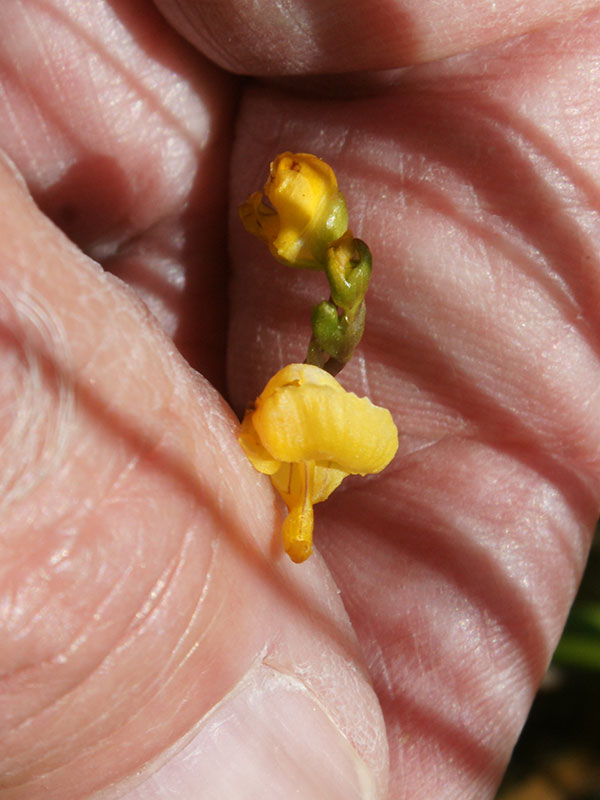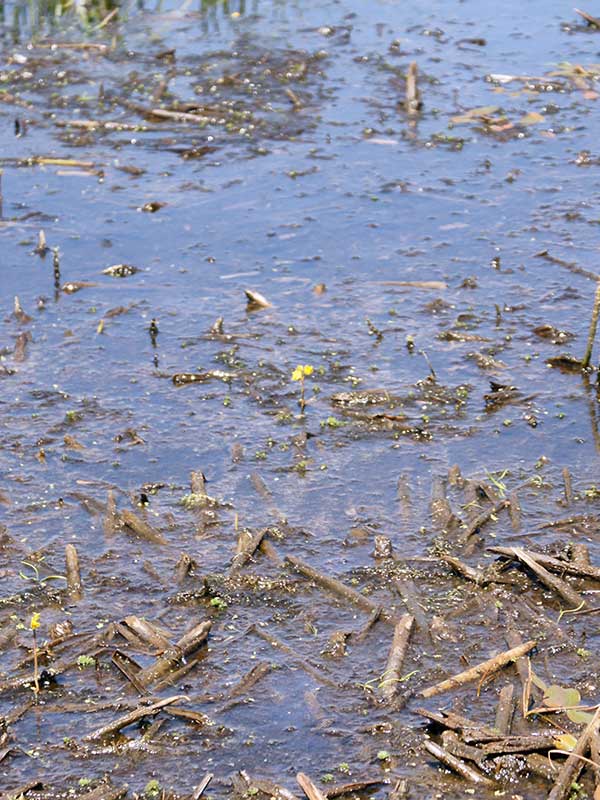Utricularia macrorhiza / common bladderwort
- free-floating aquatic perennial; only the flowers are above water
- yellow, snap-dragon-like flowers; up to 20 per stalk; ca. 1″ across
- very fine “leaves” underwater, supported by small (1/8″) bladders
- carnivorous and/or symbiotic – bladders capture/digest v. small animals, harbor symbionts
Synonym: Utricularia vulgaris
Common bladderwort is a free-floating aquatic perennial. Except when growing in wet surface muck, the leaves are just below the surface of the water. Finding it often requires slogging out into the muck of a pond or fen, and the flowers aren’t all that big, so it is often overlooked. On the other hand, the flowers are bright yellow, so some swamp lovers (no names, here) will venture after it anyway.
Common bladderwort is native to the Northern Hemisphere, and is found in all 50 states, often in water up to 6 feet deep. In the Valley, it occurs in the central fens and probably seeps and other wetlands. It can be locally common. The plants are free-floating with no roots. There is, however, a web of submerged growth that appears to be roots. Actually it is finely divided leaves covered in muck.
The flowers, which may be all you ever see, grow above water. They look sort of like mini-snapdragons. They are yellow, two-lipped with a forward-facing spur on the lower lip. The lower lip has fine red veins. The spur is nearly as long as the lower lip. Behind the flower are 2 small, egg-shaped, green sepals, which matters if you have more than one bladderwort species in your hand. The individual flowers are almost global and ½ to ¾-inch in diameter; they are the largest of any bladderwort flowers. The flowers are borne in groups of up to 20 on a reddish-green stalk (scape) in a raceme arrangement, and can stand as much as 8 inches above the water.
Flowering can happen anytime that the water is open and at least a little warm, from early spring through mid-September. Although the flowers do produce seeds, the perenniality of the plant in harsh conditions is due to the formation of turions in the autumn. These are overwintering vegetative buds that sink to the bottom.
Other than the flowers, the plant is submerged. The leaves are up to 2 inches long, and forking several times. Each segment gets progressively shorter and narrower toward the tip. Overall, this looks sort of like a zig-zagging net. The leaves hardly look like leaves, really, and to make them even less commonplace, they have numerous well-developed bladders, dark red to black and ca. 1/8 inch diameter. Among other things, these are air filled and help keep the leaves afloat. And in autumn, they fill with water to help sink the plants to the bottom.
But all that is really rather boring compared to the…
Interesting bits – First and foremost, bladderworts are carnivorous. Keep your children close to you. At least if they are very small. Utricularia is the largest genus of carnivorous plants, with more than 220 species throughout the world.
The “bladders”, from which the common named is derived, in addition to being flotation devices, are used to capture small aquatic organisms. Hairs at the opening of the bladder serve as triggers, and when contacted, mechanically cause the trap to spring open, drawing in water and organisms like a vacuum. The whole opening and closing takes about 2 milliseconds. Enzymes and/or bacteria inside the traps aid in digestion. If the prey is too big to all fit inside, the bladders will digest the accessible bits first, then work their way along the rest of the body.
The point of this would seem to be to get nutrients. How effective can that be? And could these plants be part of a biological control project? Maybe. In laboratory studies (needing further follow up in the field), bladderworts were capable of completely controlling mosquito larval populations. However, the experiments involved prolonged starvation of the plants prior to placing them in water with mosquitos.
But there is more. Among scientists who study bladderworts, the bladders have often been observed to contain communities of microorganisms (bacteria, single-celled algae, and diatoms), not as prey, but as symbionts with some putative mutually beneficial relationships. One study, for example, concluded:
Utricularia benefits both from high nutrient concentrations in the water and from successful prey capture. Abundant traps are formed only by well-nourished plants growing in waters rather rich in nutrients. In such water bodies, prey objects of all kinds are more abundant as well. Thus, the benefit gained from prey is much higher in [waters of moderate levels of dissolved nutrients] than in [conditions of serious nutrient deficiency]. The contribution of pollen grains and algae to the nutrition of the plant is comparable with the benefit gained from prey animals. Annals of Botany, 2015. Cited at SW Colorado Wildflowers.
All-in-all, it might just be worth getting out your wellies or waders.
| Color | |
|---|---|
| Family | |
| Blossom size | |
| Inflorescence size | |
| Inflorescence type | |
| When? | |
| Where? |



